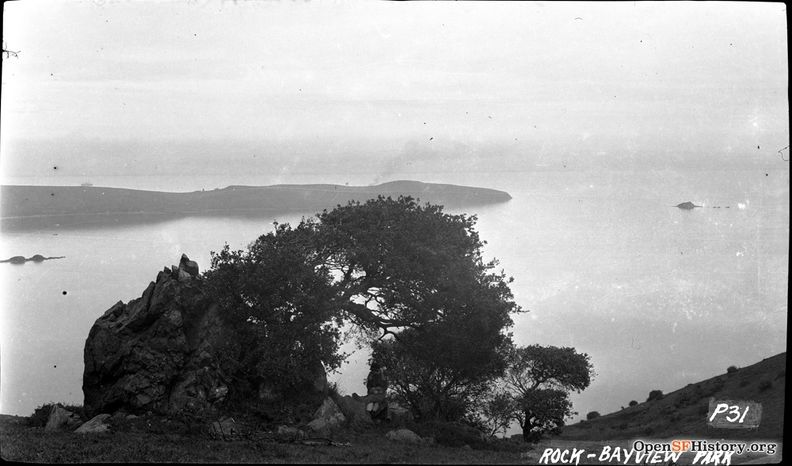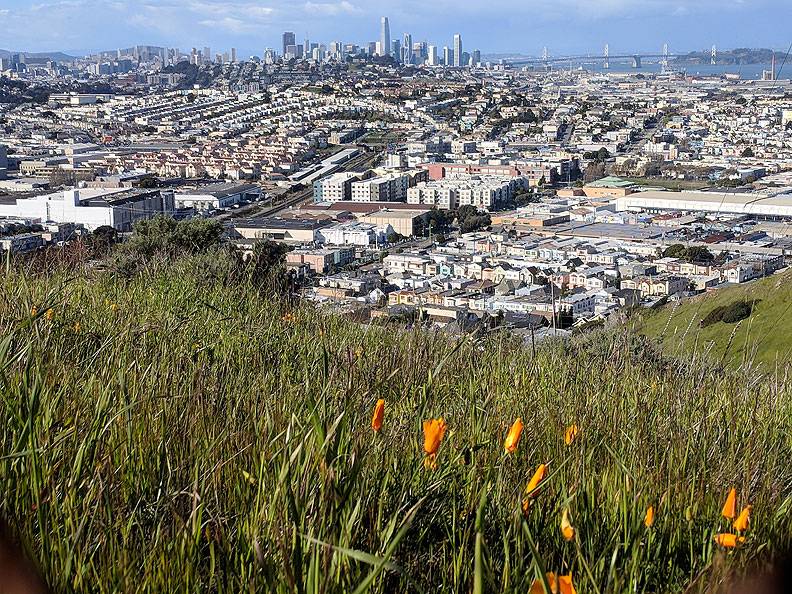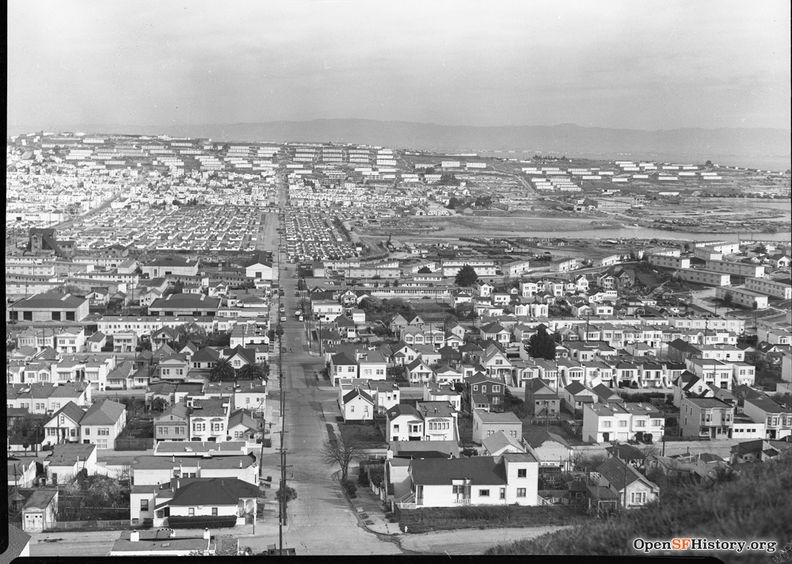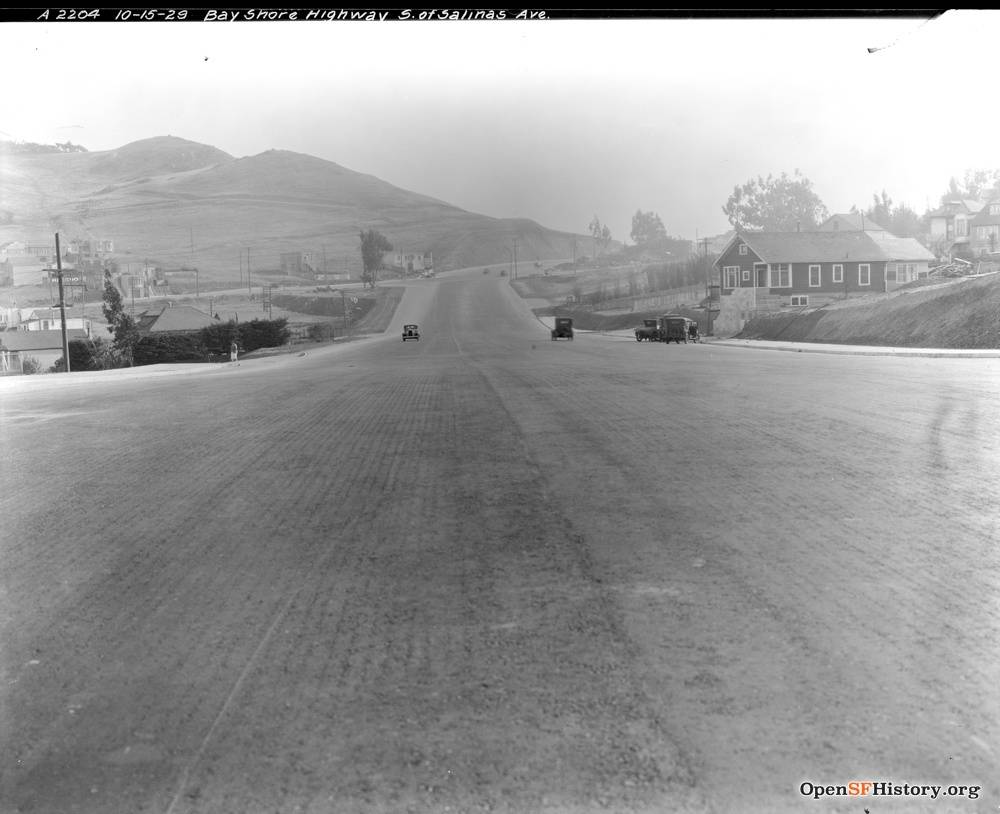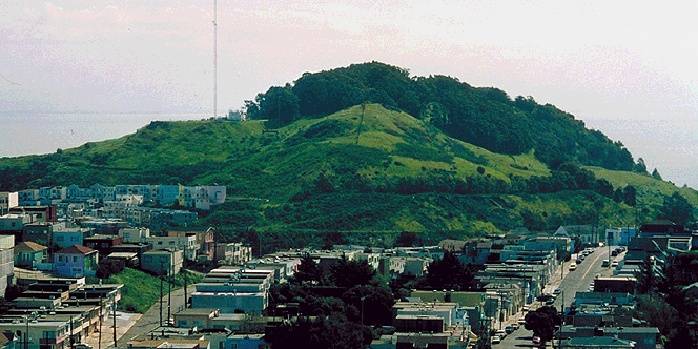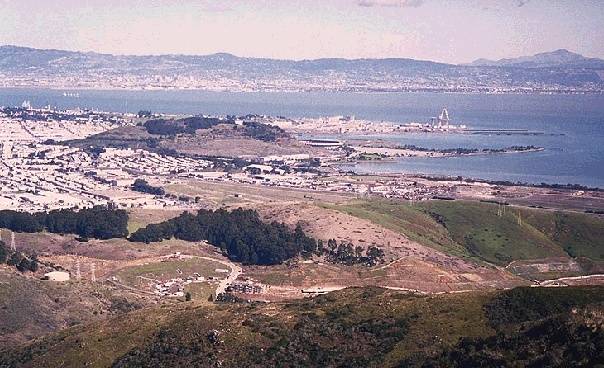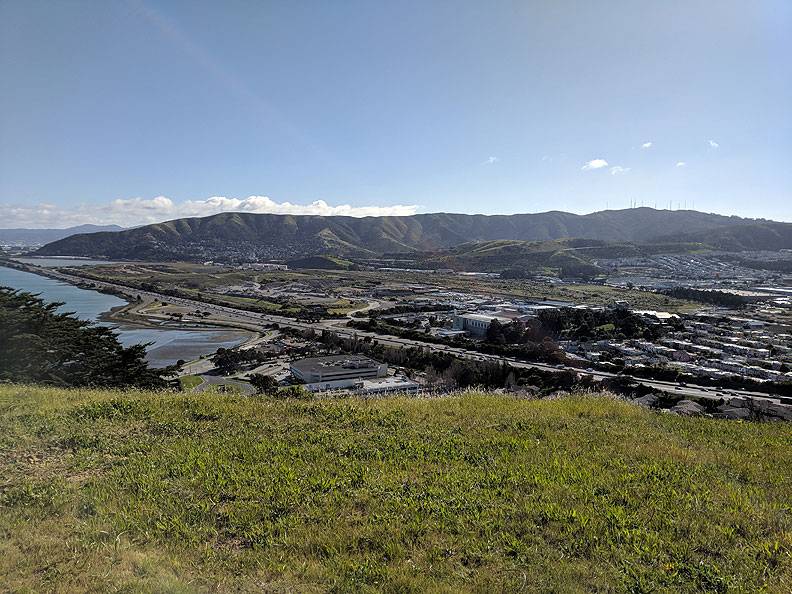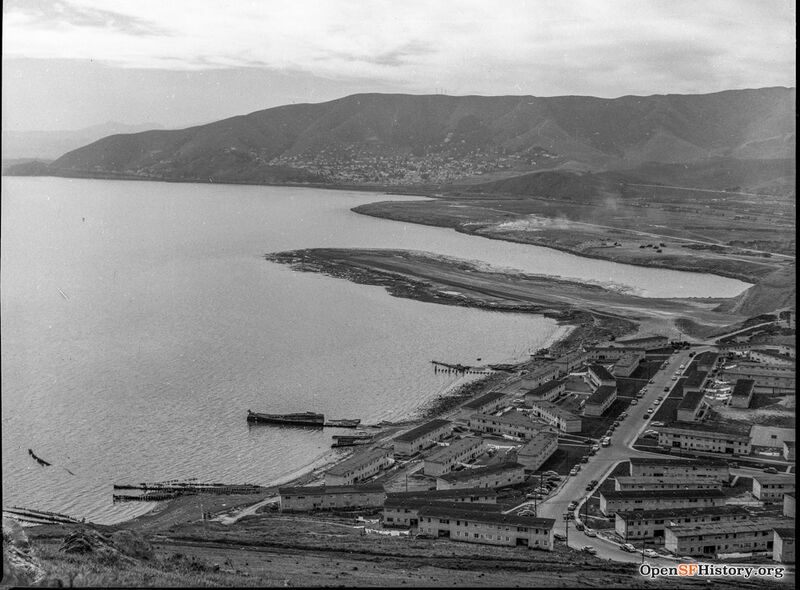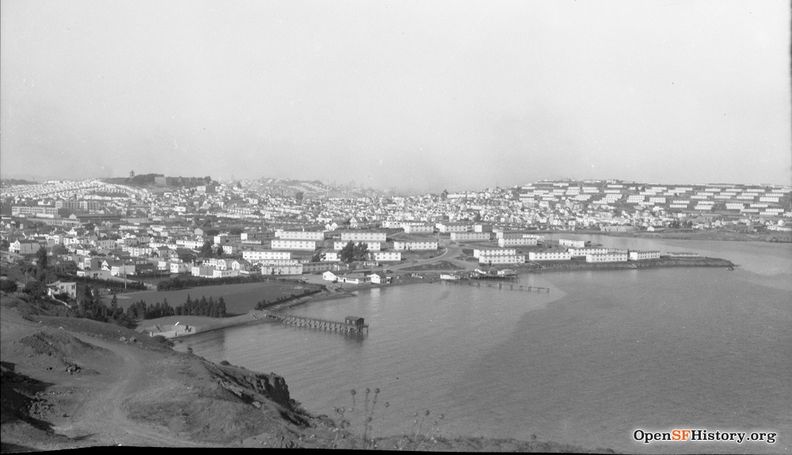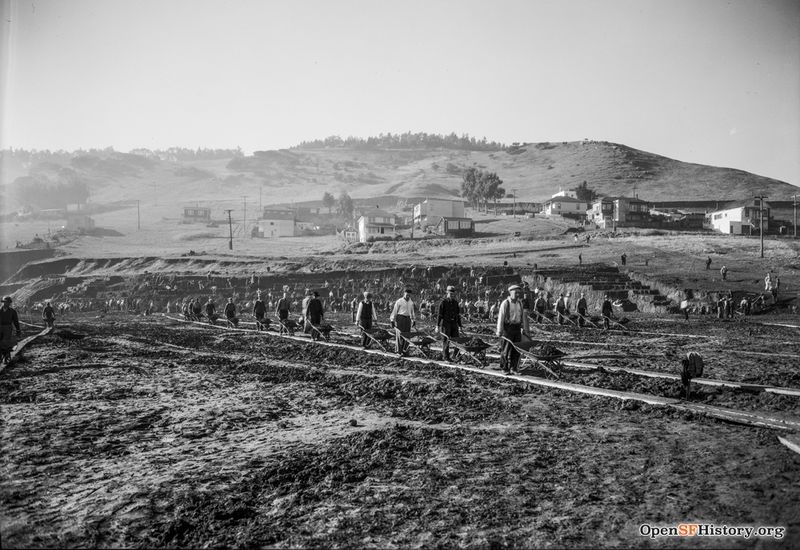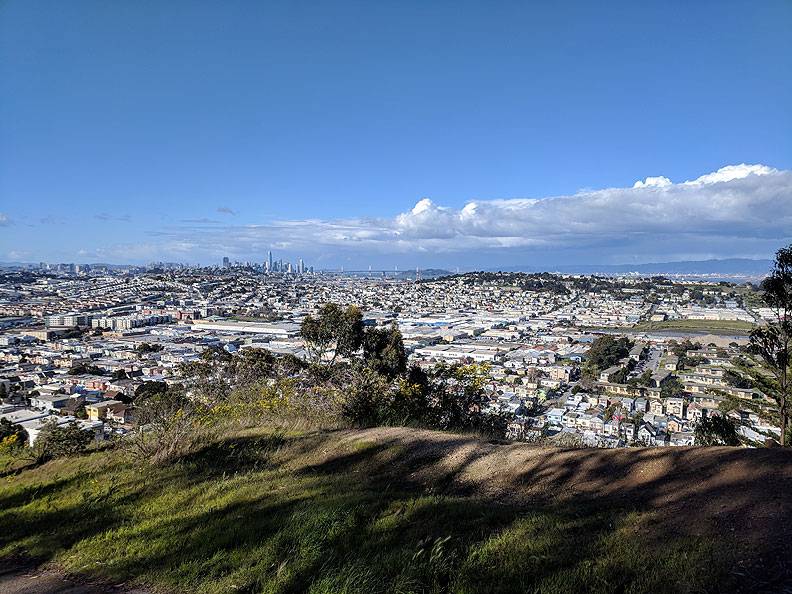Bayview Hill: Difference between revisions
No edit summary |
(added photo) |
||
| (6 intermediate revisions by 2 users not shown) | |||
| Line 3: | Line 3: | ||
''by Pete Holloran'' | ''by Pete Holloran'' | ||
[[Image: | [[Image:Bayview Hill Feb 1927 wnp14.0147.jpg|792px]] | ||
''' | '''Bayview Hill view northeasterly, February 1927.''' | ||
'' | ''Photo: OpenSFHistory.org wnp14.0147'' | ||
[[Image:View-north-from-Bayview-Hill-w-flowers 20180325 164316.jpg]] | |||
'''View north from Bayview Hill in March, 2018.''' | |||
''Photo: Chris Carlsson'' | |||
[[Image:HPC8905.jpg]] | |||
'''Hikers gaze at view from rock outcropping atop the western edge of Bayview Hill, early 20th century.''' | |||
''Photo: Private collection, San Francisco, CA'' | |||
[[Image:View North from Bayview Hill across Bayview District to Hunters Point, Yosemite slough 1953 wnp28.1106.jpg|792px]] | |||
'''View north from Bayview Hill across Bayview district to Hunters Point and Yosemite Slough, 1953.''' | |||
''Photo: OpenSFHistory.org wnp28.1106'' | |||
[[Image:Wnp26.133 bay shore hwy south of salinas avenue.jpg]] | |||
'''Third Street extending to Bay View Hill, c. 1929. To the left of this picture lies Candlestick Point, which eventually became the site of [[Candlestick Swindle | Candlestick Park]] after a series of financial and political manipulations in the late 1950s.''' | |||
''photo: [http://opensfhistory.org/Display/wnp26.133.jpg OpenSFHistory] / wnp26.133.jpg'' | |||
[[Image:bayvwhp$bay-view-hill-1929$bayviewhill_itm$bayview-hill-1999.jpg]] | [[Image:bayvwhp$bay-view-hill-1929$bayviewhill_itm$bayview-hill-1999.jpg]] | ||
| Line 24: | Line 48: | ||
Towards the top of the hill the grasslands are replaced by eucalyptus plantations and, remarkably, a remnant shrub woodland with coast live oaks (''Quercus agrifolia'') and islay cherry (''Prunus ilicifolia''). (Islay is one of the names for this plant in the local Ohlone language; Islais Creek is San Francisco's only place name derived from the Ohlone language.) Outcrops of the underlying Franciscan radiolarian chert appear throughout the woodland and grassland. In the 1930s work crews from the New Deal WPA built several retaining walls and steps using local chert blocks. In a modern update of this WPA activity, staff and volunteers from the city's Natural Areas Program remove invasive weeds like fennel and french broom from the hill. They work closely with crews of local residents employed by the San Francisco League of Urban Gardeners and other community development organizations. | Towards the top of the hill the grasslands are replaced by eucalyptus plantations and, remarkably, a remnant shrub woodland with coast live oaks (''Quercus agrifolia'') and islay cherry (''Prunus ilicifolia''). (Islay is one of the names for this plant in the local Ohlone language; Islais Creek is San Francisco's only place name derived from the Ohlone language.) Outcrops of the underlying Franciscan radiolarian chert appear throughout the woodland and grassland. In the 1930s work crews from the New Deal WPA built several retaining walls and steps using local chert blocks. In a modern update of this WPA activity, staff and volunteers from the city's Natural Areas Program remove invasive weeds like fennel and french broom from the hill. They work closely with crews of local residents employed by the San Francisco League of Urban Gardeners and other community development organizations. | ||
[[Image:View-south-from-Bayview-Hill-towards-SB-Mtn 20180325 163700.jpg]] | |||
'''March 2018 view south from Bayview Hill towards San Bruno Mountain in distance, with the former landfill site for San Francisco's garbage in the foreground, west of Highway 101.''' | |||
''Photo: Chris Carlsson'' | |||
[[Image:View From Bayview Hill 1953 opensfhistory wnp28.1111.jpg|800px]] | |||
'''View From Bayview Hill 1953.''' Causeway for Highway 101 under construction. Candlestick Cove housing still in place in foreground bottom. | |||
''Photo: Opensfhistory wnp28.1111'' | |||
In the late 1890s George Randolph Hearst and his Bay View Land Company sought to build luxury homes on the hill, but the plan floundered because of its distance from downtown. In 1902 the city purchased the hilltop with plans to build a quarantine facility. Charles Crocker, who feared that his extensive holdings in nearby Visitation Valley and San Bruno Mountain would lose value if such a facility was built, donated his lands on Bayview to the city with the condition that it abort its plans. It became dedicated park land in 1915. | In the late 1890s George Randolph Hearst and his Bay View Land Company sought to build luxury homes on the hill, but the plan floundered because of its distance from downtown. In 1902 the city purchased the hilltop with plans to build a quarantine facility. Charles Crocker, who feared that his extensive holdings in nearby Visitation Valley and San Bruno Mountain would lose value if such a facility was built, donated his lands on Bayview to the city with the condition that it abort its plans. It became dedicated park land in 1915. | ||
| Line 30: | Line 67: | ||
Access to the city-owned property at the top is by foot or bicycle only. Park at the end of Key Avenue on its northwest slopes. | Access to the city-owned property at the top is by foot or bicycle only. Park at the end of Key Avenue on its northwest slopes. | ||
<iframe src="https://archive.org/embed/a-silent-ride-around-bayview-hill" width="640" height="480" frameborder="0" webkitallowfullscreen="true" mozallowfullscreen="true" allowfullscreen></iframe> | |||
'''Silent video of a bike ride around the top of Bayview Hill, April 2020.''' | |||
''Video: Chris Carlsson'' | |||
[[Image:Bayview Hill view 1949 View Northeast. Before Bay fill for Candlestick Park, Gilman Playgound in left foreground, Hunters Point Housing and Yosemite Channel wnp14.2610.jpg|792px]] | |||
'''Bayview Hill, 1949 view to the northeast.''' This is before carving and landfilling for Candlestick Park began, but after the 1930s construction of Gilman Playground which is in the left foreground, along with Hunters Point housing and the Yosemite Slough channel. | |||
''Photo: OpenSFHistory.org 14.2610'' | |||
[[Image:Grading Gilman Playground Jan 6 1934 wnp14.2410.jpg|800px]] | |||
'''Grading Gilman Playground, Jan. 6, 1934.''' | |||
''Photo: OpenSFHistory.org 14.2410'' | |||
[[Image:View-north-from-Bayview-Hill 20180325 165442.jpg]] | |||
'''Long view north from Bayview Hill, March 2018.''' | |||
''Photo: Chris Carlsson'' | |||
[[Innes Avenue| Prev. Document]] [[Quesada and 3rd |Next Document]] | [[Innes Avenue| Prev. Document]] [[Quesada and 3rd |Next Document]] | ||
[[category:Bayview/Hunter's Point]] [[category:1890s]] [[category:1910s]] [[category:1920s]] [[category:1990s]] [[category:Ecology]] [[category:Species]] [[category:Habitat]] | [[category:Bayview/Hunter's Point]] [[category:1890s]] [[category:1910s]] [[category:1920s]] [[category:1930s]] [[category:1950s]] [[category:1990s]] [[category:Ecology]] [[category:Species]] [[category:Habitat]] [[category:1940s]] [[category:shoreline]] [[category:2010s]] [[category:2020s]] [[category:Hills]] [[category:Parks]] [[category:Roads]] | ||
Latest revision as of 15:19, 4 April 2023
Historical Essay
by Pete Holloran
Bayview Hill view northeasterly, February 1927.
Photo: OpenSFHistory.org wnp14.0147
View north from Bayview Hill in March, 2018.
Photo: Chris Carlsson
Hikers gaze at view from rock outcropping atop the western edge of Bayview Hill, early 20th century.
Photo: Private collection, San Francisco, CA
View north from Bayview Hill across Bayview district to Hunters Point and Yosemite Slough, 1953.
Photo: OpenSFHistory.org wnp28.1106
Third Street extending to Bay View Hill, c. 1929. To the left of this picture lies Candlestick Point, which eventually became the site of Candlestick Park after a series of financial and political manipulations in the late 1950s.
photo: OpenSFHistory / wnp26.133.jpg
Bayview Hill in 1999
photo: Chris Carlsson
Bayview Hill and Hunters Point shipyard seen from San Bruno Mountain. Candlestick is visible to the right of Bayview Hill, and the former naval shipyard (now an EPA Superfund site) sprawls into the bay.
photo: Chris Carlsson
The little-visited city park at the top of this hilltop in southeast San Francisco near Candlestick Park offers dramatic views of the bay and city. It is also a refuge for some of the largest and richest native grasslands in San Francisco. Fields of goldfields (Lasthenia californica), California buttercup (Ranunculus californicus), checkerbloom (Sidalcea malvaeflora), native bunchgrasses and many other wildflowers dazzle the visitor during mid-spring. Rare plants such as the San Francisco Chinese houses (Collinsia multicolor) and the coast larkspur (Delphinium californicum) are found nowhere else in San Francisco.
Towards the top of the hill the grasslands are replaced by eucalyptus plantations and, remarkably, a remnant shrub woodland with coast live oaks (Quercus agrifolia) and islay cherry (Prunus ilicifolia). (Islay is one of the names for this plant in the local Ohlone language; Islais Creek is San Francisco's only place name derived from the Ohlone language.) Outcrops of the underlying Franciscan radiolarian chert appear throughout the woodland and grassland. In the 1930s work crews from the New Deal WPA built several retaining walls and steps using local chert blocks. In a modern update of this WPA activity, staff and volunteers from the city's Natural Areas Program remove invasive weeds like fennel and french broom from the hill. They work closely with crews of local residents employed by the San Francisco League of Urban Gardeners and other community development organizations.
March 2018 view south from Bayview Hill towards San Bruno Mountain in distance, with the former landfill site for San Francisco's garbage in the foreground, west of Highway 101.
Photo: Chris Carlsson
View From Bayview Hill 1953. Causeway for Highway 101 under construction. Candlestick Cove housing still in place in foreground bottom.
Photo: Opensfhistory wnp28.1111
In the late 1890s George Randolph Hearst and his Bay View Land Company sought to build luxury homes on the hill, but the plan floundered because of its distance from downtown. In 1902 the city purchased the hilltop with plans to build a quarantine facility. Charles Crocker, who feared that his extensive holdings in nearby Visitation Valley and San Bruno Mountain would lose value if such a facility was built, donated his lands on Bayview to the city with the condition that it abort its plans. It became dedicated park land in 1915.
It wasn't long before Bayview Hill suffered the indignity of urbanization. Nearly fifty years ago its eastern slopes, once much more extensive (visible in the 1920s photo above), were leveled and dumped into the bay to create Candlestick Park. Quarrying along its southern slope destroyed one of San Francisco's largest prehistoric archeological resources, a midden known as Bayshore Mound.
Access to the city-owned property at the top is by foot or bicycle only. Park at the end of Key Avenue on its northwest slopes.
<iframe src="https://archive.org/embed/a-silent-ride-around-bayview-hill" width="640" height="480" frameborder="0" webkitallowfullscreen="true" mozallowfullscreen="true" allowfullscreen></iframe>
Silent video of a bike ride around the top of Bayview Hill, April 2020.
Video: Chris Carlsson
Bayview Hill, 1949 view to the northeast. This is before carving and landfilling for Candlestick Park began, but after the 1930s construction of Gilman Playground which is in the left foreground, along with Hunters Point housing and the Yosemite Slough channel.
Photo: OpenSFHistory.org 14.2610
Grading Gilman Playground, Jan. 6, 1934.
Photo: OpenSFHistory.org 14.2410
Long view north from Bayview Hill, March 2018.
Photo: Chris Carlsson

